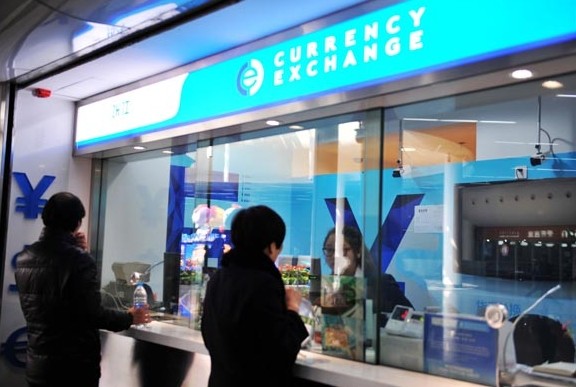

A currency exchange counter at a subway station in Shanghai. The yuan closed at 6.1781 to the dollar on Monday, down 285 basis points from Friday. Provided to China Daily
A more flexible and volatile exchange rate is likely to give riseto more genuine participationand less speculation
The good old days are gone when speculation simply refers to acquisition when it comes to the Chinese yuan.
Now that the decade-long expectation of appreciation is in tatters, traders will have to use more brain than brawn if they want to keep themselves in the game.
While the central bank has always preached the idea of a free-floating yuan, the People's Bank of China finally practiced it by doubling the currency's daily trading band to 2 percent on either side of the daily reference rate.
Zhou Xiaochuan, the central bank governor, has been pushing the idea for years, but traders really started to embrace it this time as their long positions suffered badly from a nosedive in the yuan's exchange rate.
The yuan lost 1.4 percent in February along with another 1.2 percent lost so far this month, following 10 years of appreciation.
Morgan Stanley estimated that $150 billion of redemption forward contracts - a main tool to bet on yuan's appreciation - remains in the market.
And, assuming contracts are 24 months in tenor, investors will see about $4.8 billion in total losses for every 100 basis points the yuan reaches above the level of 6.20 per dollar.
But what really caused them to rethink their strategy were remarks by another governor from the other side of the globe.
Last week, United States Federal Reserve Chairwoman Janet Yellen raised the possibility of an earlier-than-anticipated rise in US interest rates next year.
At a scheduled meeting, Yellen said a further cutback on the bond-buying program, by $10 billion to $55 billion a month, and adjusting its guidance on interest rates. She added that the "considerable period" between the end of the Fed's economic stimulus program and the first rate increase could be six months, meaning that the first rate hike could happen as early as spring next year.
Higher interests rates in the US, analysts said, would reshuffle the pattern of international fund flow in place since the global financial crisis in 2008, driving funds back to dollar assets and weakening emerging market currencies, including the yuan, against the greenback.
After Yellen made the comments on Friday, the yuan continued to weaken against the dollar, trading as low as 6.22 at one point, its weakest level in more than a year.
"The yuan has gone from being a most attractive carry trade bet in emerging markets to the worst in two months as the central bank's efforts to weaken the currency has caused volatility to surge," Geoffrey Kendrick, head of Asian currency and rates strategy at Morgan Stanley, said at a news conference last month.
"Implied volatility in the currency rose in February by the most since May, when the Fed first signaled plans to cut stimulus."
Shen Jianguang, Hong Kong-based chief economist with Mizuho Securities Asia Ltd, wrote in a commentary on Tuesday that the yuan has entered into a "new era of two-way fluctuation".
Room for appreciation is "very limited", he wrote, given that China's trade surplus has been shrinking, labor costs are rising, and it has already strengthened by more than 40 percent against the dollar since 2005.
Room for depreciation is limited, too, as the direction for fund flow is still inbound, and China's economic growth is still one of the world's fastest despite its recent deceleration.
"Two-way fluctuation against the US dollar will happen more frequently and in a bigger range this year, while the yuan will remain basically stable against a basket of currencies," Shen said.
Bank of China Ltd said in a report that the yuan's recent decline will be short-lived and that China's trade surplus and huge foreign exchange reserve will support the currency's long-term appreciation.
Nathan Chow, a Hong Kong-based economist with DBS Bank Ltd, said that the recent yuan weakness and narrower onshore-offshore yuan spread are unlikely to reverse the currency's increasing global role in trade finance activities
"A more flexible and volatile yuan exchange rate is likely to give rise to more genuine participation and less speculation in such activities," he wrote. "The longer-term growth in yuan trade finance will be motivated more by companies seeking cost advantages and a desire to mitigate foreign exchange risks."
On Tuesday, the yuan jumped on expectation that recent economic weakness will prompt Beijing to stimulate growth.
The yuan opened at 6.1828 per dollar, 131 basis points higher than Monday's close of 6.1959, amid a 26-basis-point increase in the daily reference rate to 6.1426.
The jump came as the flash manufacturing Purchasing Managers' Index, issued by HSBC Holdings Plc, fell to 48.1 in March, its lowest level since July 2013. The PMI was down from February's final reading of 48.5 and 49.5 in January. It disappointed analysts who expected a modest pickup.
Signs of a slowdown in China's economic growth were also factors in the yuan's previous weakening. A report released earlier in March revealed that Chinese exports declined by more than 18 percent in February from a year earlier, compared with a 10.6 percent increase in January, and a market expectation of a 6.8 percent increase.
Yuan weakens again amid new QE stance
2014-03-21Chinese airlines lose on depreciation of yuan
2014-03-20Yuan exchange rate flux seen as ‘normal‘
2014-03-19Yuan eases on widened trading band
2014-03-18What comes after a more flexible yuan?
2014-03-17Copyright ©1999-2018
Chinanews.com. All rights reserved.
Reproduction in whole or in part without permission is prohibited.